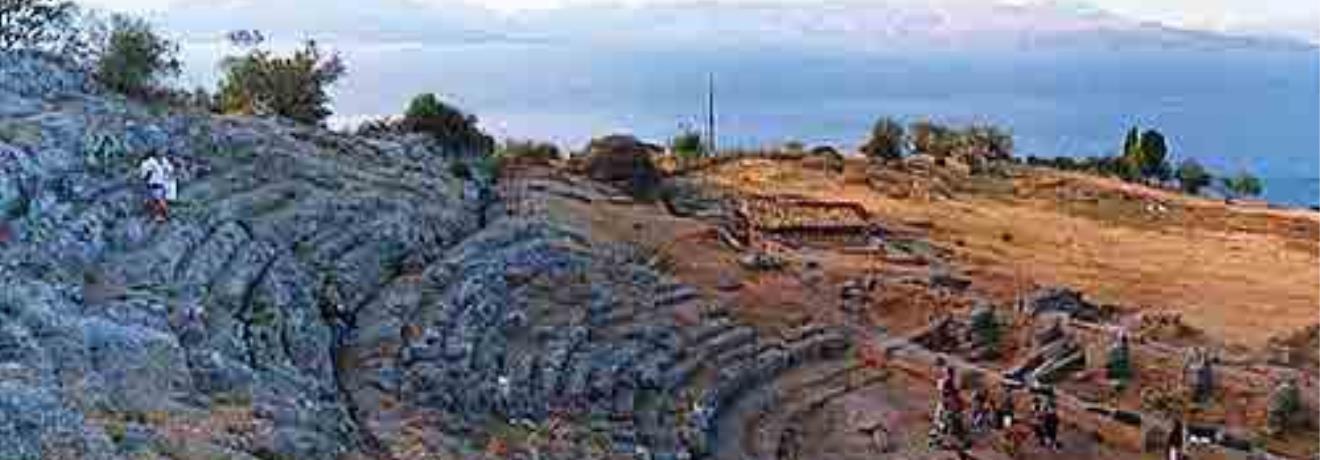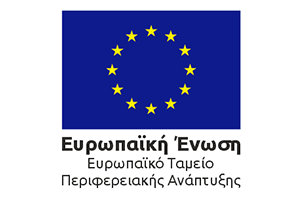Ancient Aigeira (in the province of Achaia) lies on the north coast of the Peloponnese
- roughly opposite Delphi - at the opening of a valley which leads directly into
the Corinthian gulf; together with Pellene, it represents the easternmost city
of the ancient region of Achaia.
Excavated finds revealing human activity and dating to the advanced
late neolithic period have been found on the acropolis hill, which lies 416 m.
above sea level; while excavated remains, in the same location, of a late Mycenaean
settlement of the early 12th century B.C. constitute the beginning of a continuous
settlement. The remains of a mansion and abundant finds point to a settlement
structure, which developed during the period of foreign migrations and can be
situated in the late Mycenaean koine.
In the following period, perhaps already after the 10th century B.C.,
an early Greek sanctuary was erected on the acropolis, a sanctuary which was continually
rebuilt and which continued to be used into the 4th century B.C. A wide spectrum
of votive objects, as well as architectural evidence such as foundation walls
and painted roof tiles, attests to the development of this sacred centre as the
nucleus of the city of Aigeira, a city which, at least in the early period, is
to be connected with the "Hyperesia" of Homeric tradition.
For an evaluation of Aigeira in its prime, that is, at its greatest
extent measuring ca. half a square kilometer and surrounded by a circuit wall,
the excavation results from the theatre terrace in the north, beneath the acropolis
hill, are particularly instructive.
In the course of a thorough new foundation in the hellenistic period,
at about 280 B.C., a monumental, public, sacred civic centre was achieved through
the construction of a theatre and adjacent small temple; this area was continually
rebuilt up until the early Imperial period with further temples and a cult building
dedicated to Tyche. A period of usage prior to that of the theatre-complex is
not to be ruled out for an additional sanctuary to the north, from which foundations
of two further temples are preserved.
In addition to the preserved architectural elements, the sculptural
finds of the 2nd c. B.C., amongst them an over-lifesize head of Zeus by the sculptor
Eukleides, and a draped female conforming to the figure of Tyche, as well as the
mosaic floors of the small temples, attest to the high quality of the fittings
of this space and its buildings.
It is therefore not surprising that even in the 2nd c. A.D. this ensemble
attracted the attention of the travel writer Pausanias, whose short description
absolutely corresponds to the excavated finds.
Two additional public spaces, which currently cannot adequately be
classified, nevertheless at least provide evidence for the complex urban articulation
of the city. Corresponding to this is an extensive infrastructure, which above
all has to do with structures for the provision of water. An aqueduct system which
can be traced for a number of kilometres and which, coming from the south, was
carried over wide stretches through rock tunnels, guaranteed the city's water
supply. This system was continually rebuilt and remained in use from the pre-hellenistic
up until the post-antique period.
Complementing the public and sacred centre, remains of a domestic
building were cut into a terrace directly to the north-west of the acropolis.
An andron, decorated with pebble mosaics and fitted with 11 klinai, attests to
the representative pretension of this building, whose foundation date can provisionally
be placed in the 4th c. B.C. and which in any event predates the construction
of the complex of buildings at the theatre. In spite of sporadic evidence, the
situation of Aigeira for the Roman Imperial period and late antiquity is at the
moment not adequately known.
Research at Aigeira
The discovery of the site and the earliest archaeological investigations date
back to Otto Walter, who, with excavations at the theatre terrace in 1916 and
1925, initiated archaeological research at Aigeira which would have an impact
on the future. As the unstable political situation in Greece only allowed two
short seasons, the research presence of the Austrian Archaeological Institute
(?AI) at Aigeira was in this fashion founded.
The excavation campaigns, from 1972 to 2001 carried out under the
auspices of the central OAI in Wien and since 2002 conducted by the Athens Branch,
have brought to light fundamental evidence concerning the historical development
of this Greek settlement from the late Bronze Age up to the most recent past,
and the appraisal of its material culture.
W. Alzinger led the greatest part of the field research (from 1972-1988),
with systematic surface excavations on the acropolis and on the theatre terrace,
turning aside briefly for excavation in the plain of Palati north of the city.
Besides numerous individual studies on material such as sculpture, ceramic finds,
coins, and the like, as well as the study of the theatre by S. Gogos, a comprehensive
presentation of the historical development of Aigeira has resulted from these
investigations. The remains from the prehistoric and Bronze Age periods found
on the acropolis are currently the focus of intensive research by E. Alram-Stern
(OAW, Myceneaen Commission) and S. Deger-Jalkotzy (OAW, Mycenaean Commission).
Analysis of the ceramic finds from the Greek historical period from the acropolis
excavations is being carried out by G. Schwarz (IKA Graz). Preliminary research
for the final publication of the building elements and the remains from the so-called
Tycheion is the work of T. Hagn (IKA Vienna).
Between the years 1990-1997, A. Bammer pursued a comprehensive urban
survey, and investigated numerous areas of the city via intensive survey, measuring,
and cleaning. These studies incorporate the re-addressing of questions concerning
the water supply, the orientation of numerous extensive public areas, the photographing
of architectural remains from the Byzantine period, and the study of the modern
remains of the so-called "Houses of the Raisin Pickers". A surface excavation
in the plain of Zaoussis led to the partial exposure of the foundations of two
temples north of the theatre terrace.
The most recent excavations by G. Ladstatter (from 1998) continue
the study of the water supply of Aigeira, in connection with hydrogeological studies,
and concentrate on the excavation of the domestic buildings in the plain of Solon
to the north-west of the acropolis.
A selection of objects from the excavations is presented in the Archaeological
Museum at Aigion, while the head of Zeus is displayed in the National Museum at
Athens. The impressive ruins of the theatre with its connected temples, two of
which are protected by a modern shelter, provide an architectural impression of
the hellenistic building ensemble.
Georg Ladstatter. Feb 2004
This text cited Aug 2004 from the Austrian Archaeological Institute's URL http://www.oeai.at/eng/ausland/aigeira.html
which contains 4 images. 


